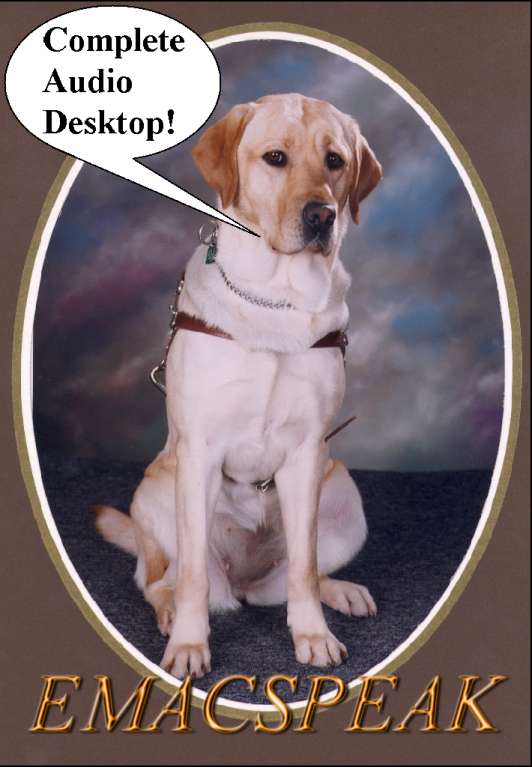
| Downloads | Reference | Installation | Usage | Tips | Tools | Support |
 |
||||||
| About the author | ||||||
Emacspeak Inc (NASDOG: ESPK) announces immediate world-wide availability of Emacspeak 17.0 --a powerful audio desktop for leveraging today's evolving semantic WWW.
Emacspeak is a speech interface that allows visually impaired users to interact independently and efficiently with the computer. Audio formatting --a technique pioneered by AsTeR-- and full support for W3C's Aural CSS (ACSS) allows Emacspeak to produce rich aural presentations of electronic information. By seamlessly blending all aspects of the Internet such as Web-surfing and messaging, Emacspeak speech-enables local and remote information via a consistent and well-integrated user interface. Available free of cost on the Internet, Emacspeak has dramatically changed how the author and hundreds of blind and visually impaired users around the world interact with the personal computer and the Internet. A rich suite of task-oriented tools provides efficient speech-enabled access to the audio desktop and evolving semantic WWW. When combined with Linux running on low-cost PC hardware, Emacspeak/Linux provides a reliable, stable speech-friendly solution that opens up the Internet to visually impaired users around the world.
You can search this site using Google.
See the online manual, productivity tips, speech-enabled applications list and the various online resources for Emacspeak locatable through Google for additional details.
Emacspeak provides complete eyes-free access to daily computing tasks. By providing fluent spoken access to local and remote electronic information, the system opens up the wealth of information available on the Internet to visually impaired users. See this case study for details.
Emacspeak introduces several improvements and innovations when compared with screenreaders designed to allow blind users to interact with personal computers. Unlike screenreaders that speak the contents of a visual display, Emacspeak speaks the underlying information. As an example, using a calendar application with a screenreader results in the blind user hearing a sequence of meaningless numbers; In contrast, Emacspeak speaks the relevant date in an easy to comprehend manner.
The system deploys the innovative technique of audio formatting to increase the band-width of aural communication; changes in voice characteristic and inflection combined with appropriate use of non-speech auditory icons are used throughout the user interface to create the equivalent of spatial layout, fonts, and graphical icons so important in the visual interface. This provides rich contextual feedback and shifts some of the burden of listening from the cognitive to the perceptual domain.
Finally, Emacspeak like Linux is completely free; in contrast, commercially available screenreaders typically double the cost of a personal computer. These innovations have together resulted in the system significantly increasing the ability of visually impaired individuals throughout the world to more effectively use information technology for work and leisure.
If you have found an innovative use for Emacspeak, you can be listed here.
This project is using Emacspeak to produce talking audio books from freely available electronic texts. From the creator of the project:
these audio products are free to individuals. we charge institutions for prepping their documents. by combining books from the gutenberg collection and emacspeak, i can make a large number of classics available to children that don't have anyone to read to them. at the same time, on the broadcasts, i can introduce these children to jazz and classical music. This is also valuable for the blind, and for english-as-a-second-language students. I believe it to have value for home schoolers. as they age, they can use the web links to further their musical education, and branch out into math and science. high school students can create radio plays from these [gutenberg] texts for performance. it is a concrete demonstration of grammatical knowledge, style and performance practice to shift a third-person novel to a first person play. House of Mapuhi on this month's broadcast is a good example. over time, this will fill the repository with NEW works. and high school computer geeks can use these materials and software to start their own broadcast facility. November 2002, mike eschman, ETC ...
There is a mailing list emacspeak@cs.vassar.edu used to disseminate information about emacspeak. If you use Emacspeak, you can subscribe by sending email to the list request address (maintained by) greg e. priest-dorman. See the news pagefor details on what's new in the latest release of Emacspeak.
See the latest release notes to see what is new in the latest release.
The Emacspeak mailing list archived at Vassar --the home of the Emacspeak mailing list-- (thanks to Greg Priest-Dorman) is another important source of frequently asked questions along with answers. Before you post a question, make sure you have read How To Ask Questions The Smart Way. Emacspeak comes with an online manual, numerous WWW resources, and full source level documentation ---make sure you've used these resources effectively.
Emacspeak comes as is, please see the accompanying Copyright notice. I work on Emacspeak in my spare time, and cannot answer questions on Emacspeak via personal email. If you do download and use Emacspeak, please participate in the Emacspeak community by subscribing to the mailing list emacspeak@cs.vassar.eduby sending a message to emacspeak-request@cs.vassar.edu .
The Emacspeak distribution comes with speech servers for IBM ViaVoice TTS (Text To Speech using a soundcard) as well as the Dectalk family of hardware speech synthesizers. Starting with Emacspeak 17.0 (HappyDog), the system also includes support for Fonix Software Dectalk. Speech servers for other synthesizers are available from Jim Van Zandt's home page. Developing speech servers for additional TTS engines is easily achieved by examining the source code of on eof the existing servers.
Emacspeak uses auditory icons to augment the user interface; the Emacspeak distribution comes with a default set of auditory icons. You can replace the default 8k auditory icons with any of the themes available --note that these are typically higher quality recordings.
T. V. Raman raman@cs.cornell.edu Last modified: Sun Nov 24 11:02:43 2002